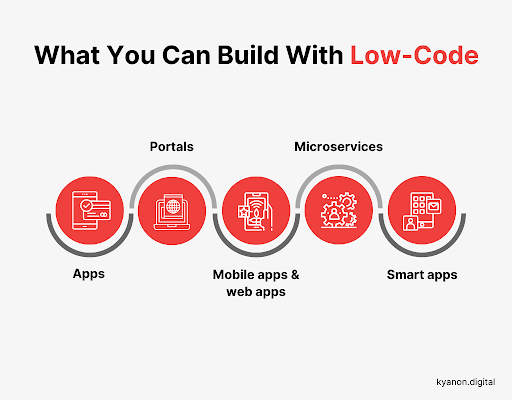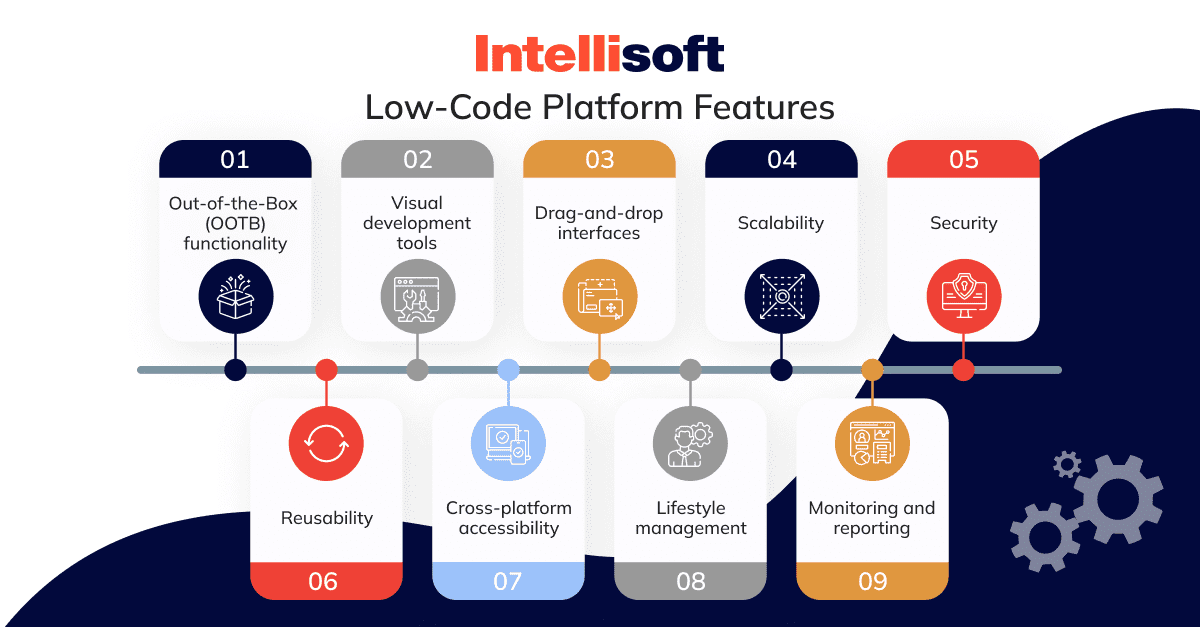Handy Ideas On Selecting Low-Code Platform Sites
Wiki Article
Advantages Of Low-Code Application Development In Terms Of Speed
Visual Development Environment (VDE):
Drag-and-Drop Interfaces: Low-code platforms provide visual tools for designing applications. Drag-and-drop tools allow developers to quickly build applications without writing lengthy code.
Many low-code platforms include built-in templates or components that enable developers to quickly test their apps and build them without having to start with a blank slate.
Reduced Coding Requirements:
Automated Code Generation: Low-code platforms automatically generate the code that is used to build the visual models created by the developers. This means that there is less manual code coding.
Reusable component: Developers may utilize the same components on different projects. This helps reduce time spent testing and writing code.
Collaboration streamlined:
Low-code development platforms are typically equipped with tools, such as deployment control, version control and testing. This allows for seamless collaboration between teams.
Citizen Development Developers, business users and other stakeholders are able to participate in application development by using user-friendly interfaces. This eliminates the bottleneck caused by absence of professional developers.
Rapid Iteration, Prototyping:
Rapid prototyping: Developers are able to quickly create prototypes to validate ideas and get feedback, resulting in quicker iteration cycles.
Simple modifications. The visual interface that low-code development offers makes it simple to modify and update applications. This speed up the process of improving and refining applications by incorporating the feedback of users.
Pre-built Integrations:
API Integrations. Low-code platforms usually have pre-built connectors and APIs for services that are popular which can reduce the amount of time required to connect other systems.
Data Integration: The tools integrated in the software make it easier and accelerate the process of linking databases, data sources, and applications.
Scaling, deployment and deployment
Many low-code platforms have one-click options for deployment, which reduces the amount of time and effort required to install applications.
Cloud-based Solutions: Cloud platforms with low-code allow developers to concentrate on the logic and functionality of their applications rather than worrying about logistics for deployment.
Low-code application development is a faster way to create apps. It simplifies and automates many aspects of the process. This makes it easier to speed up development and the ability to adapt to evolving requirements. Follow the top Low-code Platform for application development recommendations for blog advice including multiplatform mobile app development, paas service, push alerts, build a docker container, push notifications, build with docker, rad development, push notifications android, azure sql databases, multiplatform mobile app development and more.

Benefits Of Low-Code Application Development In Governance And Security
Low-code app development provides several benefits for security and governance. It is crucial to ensure that applications comply with the regulations, are secure and well-managed throughout their life. Here are some of the major benefits:
Unified Manage Console: Lowcode platforms usually offer a management console that allows administrators to oversee and manage applications.
Role-Based Access Control (RBAC): These platforms typically include robust role-based access control which allows administrators to set and enforce access policies. This permits only authorized users to change or access specific elements of a program.
Compliance and Regulatory Applicability:
A lot of low-code platforms have built-in compliance functions. For example, they are developed in accordance with the industry standards as well as regulations and laws (e.g. HIPAA, GDPR). They have frameworks and tools that help to ensure the applications are compliant with these standards.
Audit Trails & Logging: Audit trails and logs that are comprehensive can be incorporated to allow organizations to track changes, monitor access and ensure the compliance.
Enhance Security Measures
Data encryption: Low-code platforms usually provide data encryption built-in in transit and at rest. This guarantees that data sensitive information is secured.
Security Certifications - Many lowcode providers have security certificates, like ISO 27001 (or SOC2) which proves the compliance to the highest security standards. Users can be assured that the service adheres to these standards.
Automated updates to ensure security:
Regularly scheduled updates and patches Low-code platforms generally manage regular patches and updates to security automatically, ensuring that applications are protected against the most recent threats, without the need for developer intervention manually.
Security Monitoring: Tools for constant security monitoring are available. They send real-time alerts, as well as information about security concerns that could arise.
Data Governance:
Data Access policies These platforms allow organizations to determine and enforce their data access policy to ensure that only authorized users have access to the data and that it's correctly used.
Data Masking Anonymization Data Masking Tools: Built-in data masking tools and features for anonymization help safeguard sensitive data, particularly during the development and testing phases.
Consistent Lifecycle Application Management:
Pipelines for Development and Deployment: Low-code platforms often provide integrated pipelines for development and deployment which include security checks, ensuring that security remains intact throughout the entire application lifecycle.
Version Control: Integrated version control helps manage modifications and makes sure that modification to the application can be monitored and reversed if needed, maintaining the integrity of the application.
User Authentication & Authorization:
Single Sign On (SSO) Single Sign On (SSO): Supporting single sign on and other advanced authentication techniques simplify management of users while increasing security.
Multi-Factor Authentication A lot of platforms have built-in multi-factor support, adding additional security for accessing applications.
Monitoring of Policy Enforcement:
Low-code platforms are often already pre-defined with templates for policies to assist organizations in implementing security and governance policies swiftly.
Compliance Monitoring Tool: These instruments offer continuous monitoring, reporting and analysis of compliance status. It is easier to detect potential problems and take appropriate steps.
Integration into Existing Security Infrastructure:
Seamless integration: Low-code platforms can easily be integrated into the existing security tools and systems like firewalls, SIEM products (Security Information and Event Management), and identity management systems.
API Security: Integrated API security makes sure that integrations with an external systems are secure. Protect data and maintain application consistency.
Training and the best practices
Guided Best Practices : Many platforms offer guidelines and best practices to help non-developers comply with security standards.
Security Training: A few low-code providers offer security training as well as resources to educate users on how to create and maintain secure applications.
Overall, governance and application security benefits ensure that applications will be developed and maintained in a secure manner and in accordance with regulations and in control. These platforms comprise the tools and frameworks required to oversee and manage application development processes, safeguarding sensitive information while ensuring legal compliance and enforcing the policies. Take a look at the recommended great site on Enterprise application development with Low-code Platform for website advice including app platforms, rapid app development, app dev platform, ms azure sql, lowcode no code, rapid action development, rad application development, azure sql, no code platforms, build a docker container and more.

The Advantages Of Low-Code Development For Both Community And Vendor
Low-code platforms have significant advantages in terms of community support and vendor support and vendor support, both of which are vital to successful implementation, maintenance, and further improvement of apps. Here are some of the major benefits: Support from vendors
Comprehensive Technical Support:
Support Teams: Several Low-Code platforms provide access an experienced support team that assist with technical issues, advice and troubleshooting.
24/7 Support: Some companies provide 24/7 support, which is particularly beneficial for businesses that operate globally and in various time zones.
Training and Onboarding:
Vendors offer structured training programs, such as webinars tutorials, and certifications to help users become familiarized with the system.
Many vendors provide personalized onboarding to help customers use the platform efficiently and customize it to meet their requirements.
Updates and Enhancements, Regularly, and Enhancements:
Continuous Improvement: Low-code platform vendors generally release periodic updates that include the latest features, performance improvements, and security patches, ensuring that the platform stays cutting-edge and safe.
Feedback Integration: Vendors include feedback from users into their development cycles to ensure that the platform is continually evolving to meet the ever-changing needs of its users.
Comprehensive Documentation:
User documentation in detail: Users can find answers to their issues by reading a detailed and organized manual that covers all the aspects of the program beginning with its fundamental functionality to more advanced modifications.
API References: The detailed API documentation aids developers to integrate the low-code platform with other systems and customize their applications effectively.
Professional Services and Consulting:
Expert Consulting: Vendors typically offer consulting services to assist in the process of strategic planning as well as design of architecture and complicated implementations, to ensure that users have the ability to leverage the platform to its maximum potential.
Custom Development Services: A few vendors will offer custom development to build functions or integrates for their customers that are not easily available.
Community Support
Active User Communities
Forums and Discussion Panels: Many Low-code platforms feature vibrant online communities where users can ask questions, debate solutions, and work with each other on best methods.
Local and virtual User Groups These groups give you the chance to connect, share knowledge and share experiences.
Knowledge Sharing and Collaboration:
Community-Contributed Resources: Users often share templates, modules, and extensions that they have developed, which can be reused or adapted by others, accelerating development and innovation.
Crowdsourced problem solving The collective knowledge and experience of the community is an excellent resource when it comes to tackling problems and generating innovative solutions.
Learning and Development
Community-Led Training: Several communities hold workshops, training sessions and webinars. These are usually conducted by experienced users who share practical knowledge and more advanced methods.
Online Courses and tutorials Community members frequently create and distribute online courses, tutorials and guides on how-to, improving the educational resources available to all users.
Feedback and Influence
Product Feedback Channels. Forums for community members usually have channels that allow users to give feedback to the manufacturer. Feedback from customers can influence the development and improvement of features.
Beta Testing Programs. Members of the community that are active participate in beta-testing programs. They will get early access to the latest features on the platform as well as an an opportunity to shape its evolution.
Recognition and encouragement:
A lot of vendors offer community recognition programs. These programs reward active members of the community and also include MVP programs.
Peer Support: Members of the community frequently provide support to peers offering their expertise and offering guidance to less experienced users in a supportive and positive environment.
Overall, the combination of robust support from the vendor and an active connected community offers an extensive support system for the development of low-code applications. It ensures that the users are able to access the resources as well as the expertise and collaboration opportunities needed to successfully develop, deploy, and maintain their applications, ultimately enhancing productivity and innovation.
